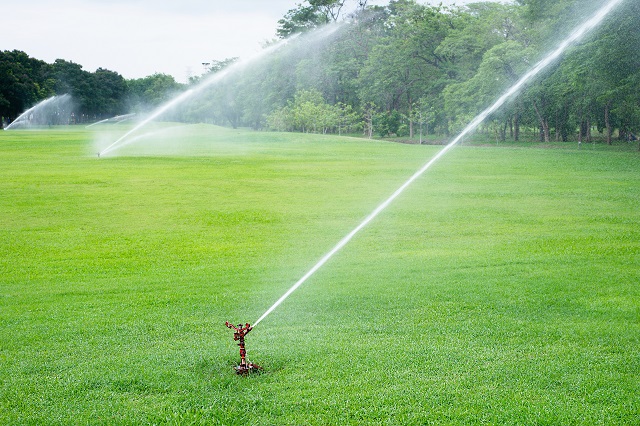Soil and Water Testing: Why Test Results Should Be Examined Together
Annual soil and water testing are sources of important data that should form a strong part of turf management decision making. Whilst they may get periodically performed, sometimes these tests are considered independent of each other, or analysed in isolation from other relevant factors which means we can miss the opportunity to join some dots on critical interactions occurring between them.
Regular soil testing allows us to monitor for both significant and subtle changes in our soil chemistry that occur due to a range of causes. It’s the monitoring, data archiving and review over time that allows us to amend our soils steadily, ensuring the changes we initiate are based on evidence and, as much as possible, occur at speeds and in ways nature is happy to cooperate with. We know our soils are a dynamic environment – they change in response to many forces – both biotic and abiotic. We also know changes rarely happen quickly; rather they tend to occur quite progressively (almost incrementally) over time. One of the biggest influences on the direction of those very changes is the water used for irrigation. There is a common message conveyed around water and soil chemistry which is over time the soil takes on the characteristics of the water applied. This is great if the water is high quality – but can be a problem if the reverse is true. When grappling to understand the relationship between irrigation water and soil chemistry, keeping this principle front of mind will help guide you towards putting the right management approach in place.

The best approach is to stay informed of both soil and water chemistry trends so you can make amendments regularly and proactively. Doing so allows you to gently steer your soil chemistry in helpful directions. This type of ‘steady as she goes’ approach reduces the likelihood of needing amendments at a scale that is costly and at times difficult to coordinate. It allows practitioners to gently tune soil chemistry each year from an informed position, looking to work around benchmarks shown historically to be where healthy turf is supported. More importantly, try to look at soil and water chemistry together and understand how they may interact before they meet, to be ahead of the game when dealing with issues that impact turf health.
Data supported by local knowledge and experience is the best combination
The data generated by soil and water tests can be overwhelming. Furthermore, it is acknowledged there can be differing views on how to test, interpret, modify, and support good soil chemistry. To simplify, the data contained in a soil test report provides information on actual and optimal levels either for extractable quantities or relative composition of soil chemical characters (e.g., Calcium, Magnesium, Potassium, Chloride, pH, total salts, etc.). Water is much the same in that specific components of its profile (e.g., electrical conductivity, total dissolved salts, pH, chloride etc.) will be characterised and quantified. However, from the turf management perspective we want to extrapolate to what impacts will be conferred to our soils from our water. From the findings produced adjustment recommendations or activities to counter harmful impacts will be suggested based on a specified benchmark reference point.
In soil testing, a lot depends on the cation exchange capacity or CEC of the soil. Recommendations will be provided that either a) try to raise available levels of critical cations to meet a particular threshold, or b) try to reorganize the relative composition of the major components towards a predetermined relationship. The calculated CEC steers us into the appropriate analysis to apply. Acronyms you may see if analysing the data to see if enough is available for turf health may be SLAN or MLSN, or if looking more at the relationships between the major components as relative percentages you will likely see BSR. Often a report will provide the opportunity to consider both. The difference in analysis applied acknowledges that very sandy rootzones have difficulty holding cations and nutrition. Under those circumstances the priority is to get enough to support health, whereas on soils that are heavier (higher clay or OM) the focus will turn more to the organisation of the components as it is assumed the basic needs would be met and we can move further towards optimizing soil structure. Nominally, the point at which different analysis methods are applied is CEC 5.

One important point to make clear is that some of the items quoted in reports are calculations derived from multiple individual measurements. CEC itself is a calculation – not a measurement. This concept is important to understand because some data points on a report are indicators or contributors to a problem – not the problem itself. You don’t directly change soil pH for example – you change one or more components that then affect the pH. Think of it as an indirect relationship. When viewed this way, we understand pH of water and soil is the roll up of many components – not a number to be looked at in isolation. This is where help interpreting the messages and issues is important – something Nuturf can walk you through both privately and confidentially. The other message that should be considered a fundamental over-arching principle is that consistency is key. When engaging in testing, always try to ensure samples are collected in a reproducible manner (same size, volume, depth, location) and try to ensure labs used, methods employed, and calibration equations remain the same. By testing with a consistent service provider, you should have this part of the process taken care of. If in doubt – ask. This ensures that the archive that gets built remains relevant and useful over an extended period. We always want to compare same / same so if we see shifts in results, be they good or bad, we can genuinely attach these shifts to known actions for cause and effect. We don’t want shifts that are seen in the numbers to be simply a product of a different test method, sample technique or some other otherwise controllable variable.
Whilst there may be some debate in some areas, there is a consensus in the turf management community that the root systems we so heavily depend on need a healthy soil environment to thrive, and this part doesn’t need to be too complex. ‘Healthy’ could mean soil structure, chemistry, or microbiology amongst many other possible factors. It’s a broad term and can be subjective. However, it can be argued often the best person (s) to ultimately assess what ‘good’ soil health looks like on any given site, is the very people who look at that turf every day. Such individuals come to know the signs and indicators of good turf health. Point being we should look to appreciate and strike the balance of technical and practical by always referencing data produced in reports back to observable practical outcomes. If we seek to have this pragmatic approach and we reassure ourselves with the fact we as an industry have built archives of data, we regularly examine against historic outcomes we can stay focused on using our tools to guide us in the quest to produce turf surfaces in a sustainable, yet clever and uncomplicated manner.

Such a practical approach is undoubtedly of immense value but let’s not kid ourselves, the better operators will always combine their intuition with some analysis on a whole host of related matters. This is the message here. Whilst observation alone is excellent, it is far from a fool-proof system and equally, raw data alone without context can be the same. If you can combine detailed observation with an archive of data that can be compared, analysed, and overlaid on top of genuine local knowledge, it usually goes a long way towards ensuring you keep moving towards good outcomes.
Why is keeping an eye of soil and water chemistry more important this year?
A few years ago, this same question was posed because it was unclear what impact would ultimately be conferred by the lack of leaching rains at that time. As is the Australian way, we now ask exactly the same question for entirely the opposite reason. We wonder what the massive rainfall Australia has seen will have on the soil chemistry today. Depending on your circumstance, it may have been of great assistance or quite unhelpful. If sodium accumulation from a poor water source has been part of your management challenge, possibly the rains have been fruitful for its dislodging capabilities. If you had been challenged to retain critical cations and had been working up to an improved position, then possibly some of your efforts may have been partly diminished. When we have a lack of rain and see dams run low, it allows both salts and solids to concentrate. Conversely, the replenishment of such catchments can mean a dilution of problematic components resulting in an overall improvement in water quality. Whatever soil chemistry position you had achieved, and whatever water quality you experienced at the end of the dry period would likely have changed with the prevailing La Nina period. How great the change and what the current situation really is can only be established by looking.

One option worth considering at this time in addition to standard soil and water tests is a combination test called saturated paste test. In these tests soil sampled from a site can have water from the same site applied and after a vacuum is applied an examination is made of the resultant soluble components. It’s not examining the water as such, or what is attached to the soil, it looks at what is available in the soil solution after the interaction of the two so it is entirely specific to your site. Why would you consider doing this periodically? This helps to align the two independent areas of examination – water source and soil – and provides further information that each independent test is unlikely to provide alone. There is a wealth of knowledge that can allow a strong degree of extrapolation when you have both soil and water tests in hand, but sometimes looking at this test specifically can throw up a few surprising observations that can help fine tune product selections and strategies. Maybe keep this in mind as an option for winter 2022. If you want to know more have a discussion with your local Nuturf Territory Manager. Contact us at
RECOMMENDED SERVICES

Managing Soil Moisture: The Evolution of Wetting Agents

Ninemire Soil Report






